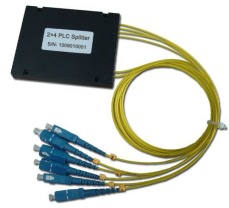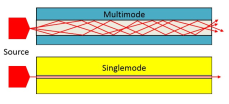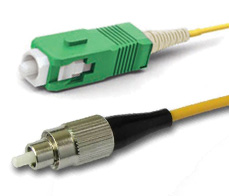 |
|
Optical transmission systems |
|
Optical transmission systems are based on the transmission of light guide fiber information. Laser diodes are used as a light source, and photodetectors are used at the other end of the fiber. Optic Fiber Optical Connectors Light sourcesIn telecommunications, invisible infrared laser light is used as a light source. The transmitted signals can be digital, two-state (on/off), or analog, where the intensity of the light beam is continuously varied according to the input electric signal. The laser diode generates so-called coherent radiation with a single wavelength. Light output power is in units of milliwatts and is enough to "shine-through" tens of kilometers of single-mode optical fiber. Light DetectorsOn the opposite side of the fiber optic cable, it is necessary to convert the light information back to the electrical signal. For this purpose, photodiodes or phototransistors equipped with a suitable amplifier are used. These components, unlike laser diodes, respond to light with a wide range of wavelengths (colors). Wave multiplexesThe optical cable is capable of simultaneously transmitting several beams of different wavelengths (colors). Therefore, systems using multiple light sources with different wavelengths have been developed. Light sources and so-called multiplexers/demultiplexers are produced for those standardised sets of wavelengths. The CWDM standard includes 18 wavelengths in the range of 1270 to 1610 nm (spacing 20 nm). The DWDM standard defines nearly 100 wavelengths near the wavelength of 1550 nm. 
Optical splittersThe light beam can be divided into several directions. Although it weakens somewhat, it is possible to serve a larger number of terminals from common center. Splitters are available with split ratios 1:2, 1:4, 1:8, 1:16, 1:32 etc. For use in wavelength multiplexed systems it is important to choose wideband devices - must be able to split all the wavelengths used. This requirement is met by PLC splitters. EMP-Centauri Optical SystemsFurthermore, up to 16 satellite polarization channels are added to the optical fiber data transmissions, with one channel simultaneously transmitting the terrestrial band. An optical transmitter converts signals from the LNB into individual light beams that are merged into a common output by the multiplexer. The optical receiver first splits all wavelengths into individual photodetectors that convert the light beam back to the electrical signal. The coaxial outputs of the receiver will provide a accurate copy of the signals coming from the LNB into the optical transmitter. |
|
Sales department: Technical support: Need more options? |
| General trade conditions (PDF) | EN |
| Method 1: Enter product's part number (at least 3 characters are required): |
|
|
| Method 2: Choose desired product category: |
|
|
| Method 3: Try out our app Design Assistant |
Switch to mobile version
© Copyright EMP-Centauri s.r.o. All rights reserved. Webmaster: support@emp-centauri.cz Background image: pixabay



 Depending on the material used, we distinguish optical fibers made from glass and plastic, with glass being of better quality. Depending on the thickness of the light-guide core, the fibers are divided into multi-mode and single-mode. High-speed data links preferably use single-mode fibers that are more demanding for manufacturing but have a very low optical attenuation (less than 1 dB per 1 km).
Depending on the material used, we distinguish optical fibers made from glass and plastic, with glass being of better quality. Depending on the thickness of the light-guide core, the fibers are divided into multi-mode and single-mode. High-speed data links preferably use single-mode fibers that are more demanding for manufacturing but have a very low optical attenuation (less than 1 dB per 1 km).
 There are several standardised types of connectors that are required for termination of the optical cable. At present, the SC/APC connector is predominant for high-speed data transmissions. The letters before of the slash indicate the mechanical design of the connector body, which can be plastic and sliding (type SC) or metal, screw type (FC type). The letters behind the slash specify how is polished contact area inside the connector, which can be either straight (PC or UPC) or sloped, angled (APC). The SC/APC connector has probably gained popularity for easy plug-in connectivity as well as suppression of light reflections on the contact surface thanks to an angle polishing.
Due to the fact that mounting of optical connectors cannot be done without special tools, optical cables are often sold with already pre-installed connectors.
There are several standardised types of connectors that are required for termination of the optical cable. At present, the SC/APC connector is predominant for high-speed data transmissions. The letters before of the slash indicate the mechanical design of the connector body, which can be plastic and sliding (type SC) or metal, screw type (FC type). The letters behind the slash specify how is polished contact area inside the connector, which can be either straight (PC or UPC) or sloped, angled (APC). The SC/APC connector has probably gained popularity for easy plug-in connectivity as well as suppression of light reflections on the contact surface thanks to an angle polishing.
Due to the fact that mounting of optical connectors cannot be done without special tools, optical cables are often sold with already pre-installed connectors.